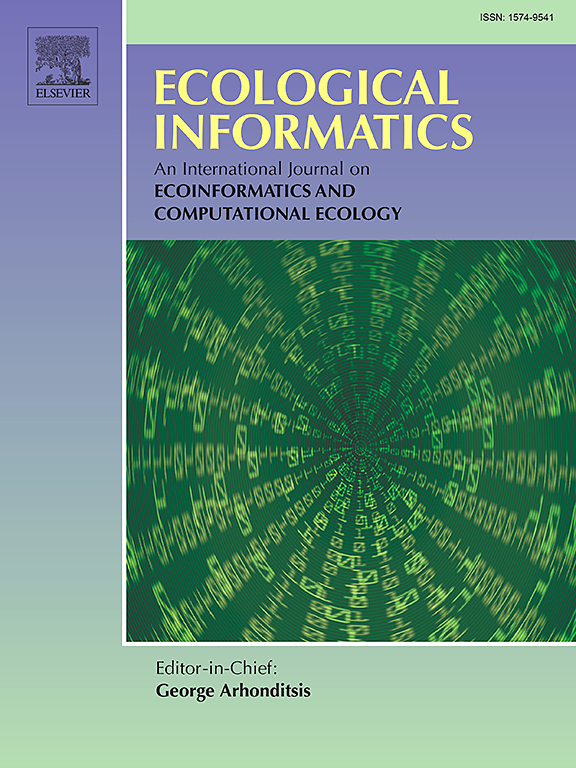回归分析与人工神经网络预测群落林松种量
IF 5.8
2区 环境科学与生态学
Q1 ECOLOGY
引用次数: 0
摘要
体积预测模型是林业的基础,因为它支持森林清查、可持续森林管理战略和综合环境规划。本研究的主要目的是实施和比较两种突出的方法-回归和机器学习-来模拟墨西哥南部社区森林中两种松物种的全树体积和茎体积。破坏性取样提供了56棵柏树和51棵假柏树的数据,覆盖了广泛的直径和高度。回归方法采用看似无关的非线性回归(NSUR)来拟合同时使用一变量和两变量模型的加性体积系统。在这种方法中,体积被建模为乳房高度(d)直径的函数,以及d和总树高(h)的函数。物种和体积类型隐含地反映在加性体系结构的结构中。对于机器学习方法,多层感知器(MLP)人工神经网络(ann)使用四个输入变量进行训练:乳房高度的直径,总树高,物种和体积类型。这些变量被明确地纳入到人工神经网络结构中,使模型能够学习复杂的非线性相互作用。采用L1正则化和Adam优化器对人工神经网络进行优化。定量变量为胸径和总树高,定性变量为种(苍叶松和假strobus)和体积类型(整树体积和茎体积),编码分别为1和0。采用相对秩法,根据拟合优度统计,包括决定系数(R2)、平均绝对误差(AAE)、总相对误差(TRE)、平均系统误差(ASE)和平均百分比标准误差(MPSE),确定最有效的模型。人工神经网络方法始终优于回归模型,在所有评估中获得更高的R2值和更低的误差度量。具体来说,人工神经网络模型减少了AAE、TRE和ASE,同时保持了生物学上的一致预测。提出的人工神经网络模型在同时和独立地模拟不同物种的全树和茎体积方面取得了重大进展,提供了可靠和精确的估计。鉴于其处理复杂非线性关系的能力及其优越的准确性,我们建议将人工神经网络作为林业应用的实用工具,包括森林资源评估和可持续森林管理计划的制定。本文章由计算机程序翻译,如有差异,请以英文原文为准。

Regression analysis and artificial neural networks for predicting pine species volume in community forests
Volume prediction models are fundamental in forestry, as they support forest inventories, sustainable forest management strategies, and comprehensive environmental planning. The main objective of this study was to implement and compare two prominent approaches—regression and machine learning—for modeling whole-tree volume and stem volume in two Pinus species in community forests of southern Mexico. Destructive sampling provided data from 56 P. patula and 51 P. pseudostrobus trees, covering a wide range of diameters and heights. The regression approach employed seemingly unrelated nonlinear regression (NSUR) to fit simultaneous additive volume systems using both one- and two-variable models. In this approach, volume was modeled as a function of diameter at breast height (d) alone and as a function of both d and total tree height (h). Species and volume type were implicitly accounted for within the structure of the additive systems structure. For the machine learning approach, multilayer perceptron (MLP) artificial neural networks (ANNs) were trained using four input variables: diameter at breast height, total tree height, species, and volume type. These variables were explicitly incorporated into the ANN structure, enabling the model to learn complex, non-linear interactions. The ANN was optimized using L1 regularization and the Adam optimizer. The quantitative variables were diameter at breast height and total tree height, while the qualitative variables were species (P. patula and P. pseudostrobus) and volume type (whole-tree volume and stem volume), both coded as 1 and 0, respectively. The relative rank method was used to identify the most effective models based on goodness-of-fit statistics, including the coefficient of determination (R2), average absolute error (AAE), total relative error (TRE), average systematic error (ASE), and mean percent standard error (MPSE). The ANN approach consistently outperformed the regression model, achieving higher R2 values and lower error metrics across all evaluations. Specifically, the ANN model reduced AAE, TRE, and ASE while maintaining biologically consistent predictions. This proposed ANN model represents a significant advancement in modeling both whole-tree and stem volume simultaneously and independently across different species, providing reliable and precise estimates. Given its ability to handle complex, non-linear relationships and its superior accuracy, we recommend the use of ANN as a practical tool in forestry applications, including forest resource evaluation and the development of sustainable forest management plans.
求助全文
通过发布文献求助,成功后即可免费获取论文全文。
去求助
来源期刊

Ecological Informatics
环境科学-生态学
CiteScore
8.30
自引率
11.80%
发文量
346
审稿时长
46 days
期刊介绍:
The journal Ecological Informatics is devoted to the publication of high quality, peer-reviewed articles on all aspects of computational ecology, data science and biogeography. The scope of the journal takes into account the data-intensive nature of ecology, the growing capacity of information technology to access, harness and leverage complex data as well as the critical need for informing sustainable management in view of global environmental and climate change.
The nature of the journal is interdisciplinary at the crossover between ecology and informatics. It focuses on novel concepts and techniques for image- and genome-based monitoring and interpretation, sensor- and multimedia-based data acquisition, internet-based data archiving and sharing, data assimilation, modelling and prediction of ecological data.
 求助内容:
求助内容: 应助结果提醒方式:
应助结果提醒方式:


